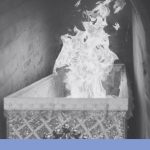
The Origins of the Burning Chapel
We’re all familiar with the term “burning chapel” (often referred to in English by the French equivalent “chapelle ardente”), which is an integral part of our funeral traditions.
A burning chapel is a temporary place specially designed for the body of the deceased to lie in state until the funeral ceremony. This is where loved ones come to keep vigil and pay their respects.
But what does “burning chapel” mean? Why does it have this very special name? Find out more about the origins of the burning chapel and its place at the heart of modern funeral rites.
The burning chapel in the Middle Ages
In medieval times, the deceased were usually laid to rest at home. However, in the case of a priest or a public figure, the body of the deceased would lie in state in the chapel instead. In this way, a larger number of visitors could come to pay their respects.
In such cases, numerous candles were used to illuminate the visitation area. This gave rise to the term “burning chapel”. This practice was in fact used for the majority of royal funeral ceremonies in the late Middle Ages.
The first written notes on the subject appear in the account of the funeral of French King Louis X, in 1316. It speaks of two burning chapels built at Saint-Denis and Notre-Dame to mark the monarch’s death.
Nevertheless, it is in the account of the funeral of René d’Anjou, who died in 1480, that the expression “chapelle ardente” is first noted.
| Note: The term “chapelle ardente” must not be confused with “chambre ardente“, which refers to a 16th-century French inquisitorial court, responsible for judging crimes against the state. |
The burning chapel of modern times
Today, a visitation parlour could be considered a modern-day burning chapel. However, while the coffin in a visitation parlour is often placed close to a wall, the coffin lying in state in a burning chapel is generally placed right in the middle of the room, allowing visitors to walk around both sides of the coffin.
The casket models used for viewing the decease in a burning chapel are fitted with a lid that can be completely removed so that the deceased is not hidden on one side by the open lid. In fact, this type of coffin is often referred to as a “priest’s coffin”, most likely in reference to the traditional use of this type of viewing.
The burning chapel can be held in a place of worship, but also in other significant locations such as a city hall, a parliament building, a museum or even an amphitheatre. In all cases, the coffin is usually placed on a raised and decorated funeral platform, known as a catafalque.
A few examples of famous burning chapels:
Queen Elizabeth II: September 15-19, 2022, the Queen of England lay in state (i.e., in a burning chapel) in London’s Westminster Hall. The line to the coffin stretched for 8 kilometres, and some visitors had to wait up to 30 hours to spend a few seconds with the late sovereign.
Maurice Richard: On May 30, 2000, some 100,000 people came to pay tribute to the Rocket at the Molson Centre, which was transformed into a burning chapel to honour the deceased.
Pope Benedict XVI: January 2-4, some 65,000 faithful bid farewell to the head of the Catholic Church, who lay in state for 3 days in a burning chapel in St. Peter’s Basilica at the Vatican.
| In memory of Michel Côté, who lay in state at the Monument-National in Montreal on June 8. |
Sources :
https://fr.wikipedia.org/wiki/Chapelle_ardente
https://www.lagentiane.org/chroniques/est-une-chapelle-ardente-3714/




